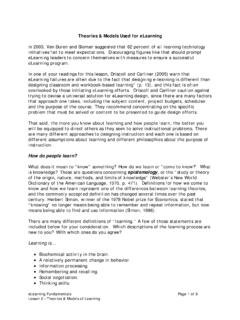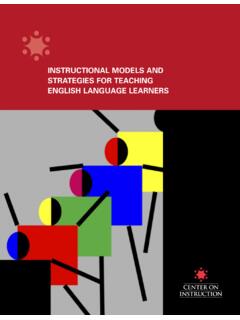Transcription of eLearning Theories Models - ITMA Instructional Technology ...
1 Theories & Models Used for eLearning In 2003, Van Buren and Sloman suggested that 62 percent of all learning Technology initiatives fail to meet expectations. Discouraging figures like that should prompt eLearning leaders to concern themselves with measures to ensure a successful eLearning program. In one of your readings for this lesson, Driscoll and Carliner (2005) warn that eLearning failures are often due to the fact that designing e-learning is different than designing classroom and workbook-based learning (p. 13), and this fact is often overlooked by those initiating eLearning efforts. Driscoll and Carliner caution against trying to devise a universal solution for eLearning design , since there are many factors that approach one takes, including the subject content, project budgets, schedules and the purpose of the course.
2 They recommend concentrating on the specific problem that must be solved or content to be presented to guide design efforts. That said, the more you know about learning and how people learn, the better you will be equipped to direct others as they seek to solve Instructional problems. There are many different approaches to designing instruction and each one is based on different assumptions about learning and different philosophies about the purpose of instruction. How do people learn? What does it mean to know something? How do we learn or come to know? What is knowledge? These are questions concerning epistemology, or the study or theory of the origin, nature, methods, and limits of knowledge (Webster s New World Dictionary of the American Language, 1970, p.)
3 471). Definitions for how we come to know and how we learn represent one of the differences between learning Theories , and the commonly accepted definition has changed several times over the past century. Herbert Simon, winner of the 1978 Nobel prize for Economics, stated that knowing no longer means being able to remember and repeat information, but now means being able to find and use information (Simon, 1996). There are many different definitions of learning. A few of those statements are included below for your consideration. Which descriptions of the learning process are new to you? With which ones do you agree? Learning Biochemical activity in the brain. A relatively permanent change in behavior. Information processing. Remembering and recalling.
4 Social negotiation. Thinking skills. eLearning Fundamentals Page 1 of 9 Lesson 2 Theories & Models of Learning Knowledge construction. Conceptual change. Contextual change (transferring knowledge from the Instructional context to a new context). Active and experiential. Distributed among the community (changes in our relation to the cultures to which we are connected). Tuning your perceptions to your immediate environment. A self-organizing phenomenon (it is affected by numerous, unpredictable variables, but when people in a system need to learn, they will). [Adapted from Jonassen, , Howland, J., Moore, J., & Marra, (2003). Learning to solve problems with Technology : A constructivist perspective. Upper Saddle River, : Merrill Prentice Hall.]
5 ] In their review of eLearning Theories , frameworks and Models , Mayes and de Freitas (2007) emphasize that it is important to be clear about the assumptions underlying eLearning designs. This is, in part, because they claim there really are no specific Models for eLearning , only enhancements of existing Models of learning which use Technology to achieve better learning outcomes. They provide the following working definitions that are helpful in any discussion of Theories , frameworks and Models : Theories of learning are empirically-based accounts of the variables which influence the learning process and provide explanations of the ways in which that influence occurs (Mayes & de Freitas, 2005, p. 5). A provides a general explanation for observations made over time, explains and predicts behavior, can never be established beyond all doubt, and may be modified.
6 Models of eLearning describe where Technology plays a specific role in supporting learning. These can be described both at the level of pedagogical principles and at the level of detailed practice in implementing those principles (ibid). Driscoll and Carliner (2005) provide another helpful definition for the phrase educational philosophy, which they define as a set of beliefs regarding the purpose of education (p. 31). Your organization s philosophy of education may be explicitly stated or unstated, but it exists, nonetheless. It is the basic beliefs about why you are initiating eLearning , and this philosophy will guide your choices from the methods you use to teach the desired outcomes, to the type of activities and technologies you select.
7 Learning Theories can provide a focal point for the reflective designer. Knowing why you do what you do in an Instructional design lends coherence and consistency to your plans, and enables you to feel confident about the basis for your design . That confidence transfers to the learners, providing a sense of security in both the ability of the instruction to meet their needs and in their own ability to learn. eLearning Fundamentals Page 2 of 9 Lesson 2 Theories & Models of Learning There are hundreds of learning Theories , but three categories remain dominant: Behaviorism, Cognitivism, and Constructivism. Some eLearning designers claim to adhere religiously to one of these categories. You may hear them say: "I'm a behaviorist." "I'm a cognitive Instructional designer.
8 " "I take a constructivist approach to designing instruction." Others take a pragmatist's approach and use "what works" - employing strategies introduced by several different Theories to accomplish their aims in instruction. Such strategies are generally based on a specific principle or assumption about learning. Some of these principles and assumptions are universally accepted and can be used to justify a variety of theoretical designs. Your readings for this lesson highlight those major categories of learning theory Behaviorism, Cognitivism, and Constructivism (Driscoll & Carliner and Ertmer and Newby readings) as well as those Theories specific to the field of distance learning (Simonson, et al, reading). In the Anderson (2008) selection, you will read about the attributes of online instruction, the role of interaction, and a potential theory and model for online learning.
9 This reading selection will highlight a few alternative Theories and Models that are being used in the field of eLearning . eLearning Fundamentals Page 3 of 9 Lesson 2 Theories & Models of Learning Other Theories Used for eLearning In addition to the Big Three learning Theories (Behaviorism, Cognitivism, and Constructivism), you will come into contact with a wide variety of other Theories , some of which are related to the Big Three and some which have evolved from the theoretical branch of social cognition. Some of the Theories and the assumptions upon which they are based are listed in the table below (from and ). Others can be viewed at: Theory (Theorists) Description Assumptions About Learning Cognitive Flexibility (Spiro) The ability to spontaneously restructure one s knowledge in many ways in adaptive response to radically changing situational demands, to facilitate the transfer of knowledge and skills to new learning situations.
10 1. Learning activities must provide multiple representations of content. 2. Instructional materials should avoid oversimplifying the content domain and support context-dependent knowledge. 3. Instruction should be case-based and emphasize knowledge construction, not transmission of information. 4. Knowledge sources should be highly interconnected rather than compartmentalized. Situated Learning (Lave) Learning is unintentional and situated within authentic activity, context and culture. Cognitive apprenticeship (Brown, Collins, & Duguid) is a related idea. 1. Learning involves legitimate peripheral participation which is usually unintentional. 2. Knowledge must be presented in authentic contexts. 3. Social interaction and collaboration are essential components.






